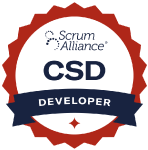Overview
Certified Scrum Developers (CSD®) have demonstrated — through training that ensures they have a working understanding of Scrum and agile principles, and have learned specialized agile engineering skills.
The Certified Scrum Developer® course is designed for product developers who are working in a Scrum environment. The goal is to expose students to the most important tools and techniques needed to build good products in the iterative and incremental fashion that Scrum requires. These ideas are central to the entire field of agile product development.
In today's competitive job market, the Certified Scrum Developer® training can set you apart from the pack. A successful Certified Scrum Developer® is committed to continuous improvement.

To earn a CSD®, we require at least two days of formal training taught by a Scrum Alliance®-approved CSD® Educator.
Once you complete your course, you will receive a notification to accept your CSD® license, and the CSD® certification will be added to your profile. Your certification is valid for two years.
Your Path with Scrum Alliance®
- Certified Scrum Developer® course
- A-CSD® course
- Certified Scrum Professional® — Developer course
GSA: $726 USD
Next Upcoming Course


Train up your teams with private group training
Have a group of 5 or more students? Cprime also provides specialist private training with exclusive discounts for tailored, high-impact learning.
Certified Scrum Developer® (CSD®) Schedule
Full Course Details
The coursework and dedication needed to achieve a CSD® sharpens your skills to help you become a better
practitioner of Scrum and agile development.
By earning a Certified Scrum Developer® certification, you:
• Learn the foundations of Scrum and the scope of the Certified Scrum Developer’s role from the best minds in development agility
• Demonstrate to employers and peers your understanding of core Scrum knowledge
• Expand your career opportunities by staying relevant and marketable across all industry sectors adopting agile practices
• Engage with a community of recognized Scrum experts who are committed to continuous improvement
Professionals who would benefit from this training include:
- Business Analyst
- Manager
- Product Manager
- Project Manager
- Team Lead
- Tester
- Programmer/Developer
- The Scrum Framework - including it's accountabilities, events and artifacts.
- How to function as a Scrum Team
- Additional agile practices such as refactoring and test-driven development will be introduced.
During your CSD® courses, you must demonstrate an understanding of Scrum and agile development practices by passing a CSD® assessment provided by your educator. The assessment may be an exam administered by the educator to test your knowledge, or it may be an active, classroom-based assessment. When a CSD® educator uploads a student’s information into our system, they are recommending the student for certification.
